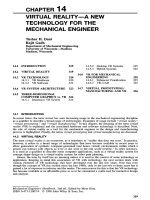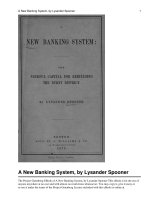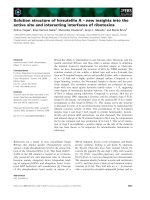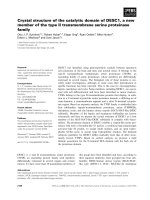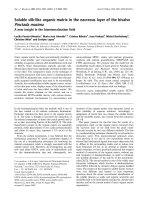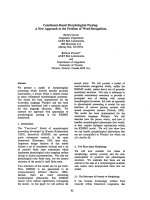university alabama press caborn-welborn constructing a new society after the angel chiefdom collapse aug 2004
Bạn đang xem bản rút gọn của tài liệu. Xem và tải ngay bản đầy đủ của tài liệu tại đây (2.32 MB, 249 trang )
Caborn-Welborn
Caborn-Welborn
Constructing a New Society after
the Angel Chiefdom Collapse
dav id poll ack
the university of alabama press
Tuscalo osa
Copyright © 2004
The University of Alabama Press
Tuscaloosa, Alabama 35487-0380
All rights reserved
Manufactured in the United States of America
Typeface: AGaramond
∞
The paper on which this book is printed meets the minimum requirements of American
National Standard for Information Science–Permanence of Paper for Printed Library
Materials, ANSI Z39.48–1984.
Library of Congress Cataloging-in-Publication Data
Pollack, David, 1951–
Caborn-Welborn : constructing a new society after the Angel Chiefdom Collapse / David
Pollack.
p. cm.
Includes bibliographical references (p. ) and index.
ISBN 0-8173-1419-9 (cloth : alk. paper) — ISBN 0-8173-5126-4 (pbk. : alk. paper)
1. Mississippian culture—Ohio River Valley. 2. Mississippian culture—Wabash River Valley.
3. Mississippian pottery—Ohio River Valley. 4. Mississippian pottery—Wabash River Valley.
5. Chiefdoms—Ohio River Valley. 6. Chiefdoms—Wabash River Valley. 7. Excavations
(Archaeology)—Ohio River Valley. 8. Excavations (Archaeology)—Wabash River Valley.
9. Ohio River Valley—Antiquities. 10. Wabash River Valley—Antiquities I. Title.
E99.M6815P68 2004
977′.01—dc22
2004000653
Contents
Illustrations vii
Tables ix
Acknowledgments xi
1. Introduction 1
2. Pre-a.d . 1400 Mississippian Regional Centers, Angel’s Collapse, and Caborn-
Welborn Developments in the Lower Ohio River Valley 11
3. Ceramic Descriptions 35
4. Site Types and Their Spatial Distribution 77
5. Temporal Trends 124
6. Cultural and Functional Ceramic Patterns 154
7. Interpretations and Conclusions 181
References Cited 211
Index 229
Illustrations
1.1. The Vacant Quarter 3
1.2. Spatial relationship between the Caborn-Welborn and Angel regions 6
1.3. Caborn-Welborn and its nearest neighbors 8
2.1. Mississippian regional centers before a.d. 1400 13
2.2. Caborn-Welborn site distribution relative to the natural environment 26
3.1. Jar rim pro¤les 39
3.2. Jar appendages 40
3.3. Bowl rim pro¤les 42
3.4. Bowl appendages and lip decoration 43
3.5. Bottle and plate rim pro¤les 44
3.6. Shallow bowls 46
3.7. Bowl ef¤gy attachments 47
3.8. Pan rim pro¤les 49
3.9. Lower Ohio Valley decorated ceramic types 52
3.10. Caborn-Welborn Decorated with lines used as ¤ll 53
3.11. Caborn-Welborn Decorated with punctation used as ¤ll 54
3.12. Caborn-Welborn Decorated 55
3.13. Caborn-Welborn Decorated, incorporating Oneota motifs 56
3.14. Caborn-Welborn Decorated jar shoulder design varieties 57
3.15. Caborn Welborn Decorated 58
3.16. Lower Ohio Valley decorated ceramic types 62
3.17. Oneota-like jar rim pro¤les 64
3.18. Oneota-like ceramics 65
3.19. Oneota-like ceramics 66
3.20. Oneota-like ceramics 67
3.21. Central Mississippi Valley–derived ceramic types 69
3.22. Central Mississippi Valley–derived ceramic types 70
3.23. Central Mississippi Valley jars and miscellaneous jars 71
3.24. Caborn-Welborn ceramic assemblage 75
4.1. Triangular endscrapers and projectile points 80
4.2. Hooper Site surface artifact distribution 85
4.3. Site 11Ga160 surface artifact distribution 86
4.4. Mulligan Site surface artifact distribution 90
4.5. Ritz Site surface artifact distribution 93
4.6. Alzey Site surface artifact distribution 97
4.7. Moore Site surface artifact distribution 99
4.8. Blackburn Site surface artifact distribution 100
4.9. Location of Slack Farm cemeteries and burial orientation 106
4.10. Distribution of houses, storage pits, and cemeteries at Slack Farm,
Area 3 107
4.11. Whole or nearly whole vessels from Slack Farm 108
4.12. Distribution of surface house stains and pit features at Hovey Lake 111
4.13. Location of burials within and outside of a Hovey Lake house basin 112
4.14. Whole or nearly whole ceramic vessels from a Hovey Lake house basin 113
4.15. Distribution of Caborn-Welborn sites within the three subareas 122
5.1. Distribution of early Caborn-Welborn subdivision components 144
5.2. Distribution of middle Caborn-Welborn subdivision components 146
5.3. Distribution of late Caborn-Welborn subdivision components 149
viii Illustrations
Ta b le s
2.1. Radiocarbon dates from Angel and Caborn-Welborn phase sites 16
3.1. Ceramic types found in the Caborn-Welborn region 37
4.1. Farmstead large ceramic collections 84
4.2. Hamlet large ceramic collections 89
4.3. Small village large ceramic collections 98
4.4. Large village large ceramic collections 110
4.5. Ceramic collections from blufftop cemeteries 116
5.1. Ceramic types recovered from the 22 sites with large ceramic collections 125
5.2. Intersite comparisons of Caborn-Welborn Decorated mean line width 138
5.3. Caborn-Welborn temporal subdivisions based on ceramics 141
6.1. Caborn-Welborn Decorated in site assemblages by subarea 157
6.2. Intersubarea comparison of the use of lines and punctations on Caborn-
Welborn Decorated jar shoulders 158
6.3. Caborn-Welborn Decorated: lines or punctations as ¤ll by subarea 158
6.4. Intersite comparisons of mortuary vessel ceramic types 160
6.5. Intersite comparisons of vessel forms from mortuary contexts 162
6.6. Intersite comparisons of bottle types from mortuary contexts 163
6.7. Intersite comparisons of bowl types from mortuary contexts 164
6.8. Ceramic types associated with each settlement type 169
6.9. Settlement type and vessel form composition 173
6.10. Pan ori¤ce diameter by settlement type 174
6.11. Bowl appendages associated with each settlement type 176
6.12. Plain jar appendages associated with each settlement type 177
This book is a revised version of my dissertation, which was completed at the
University of Kentucky in Lexington. I would like to thank my dissertation
committee (Dr. Richard W. Jefferies, Dr. John Van Willigan, Dr. Kim A.
McBride, and Dr. John Watkins) and the outside reader (Dr. Theda Perdue)
for their instructive comments and constructive criticisms. I would especially
like to thank my dissertation chair, Dr. Tom D. Dillehay, who always took the
time to discuss my research, to provide constructive criticism, and to encour-
age me to examine my data critically and from a variety of perspectives. Over
the years, Tom also has been a good friend.
This study was funded, in part, by a Dissertation Improvement Grant from
the National Science Foundation. In addition, analysis of the Slack Farm,
Caborn, and Hovey Lake ceramics was supported by a grant from the Na-
tional Endowment for the Humanities. The support of both institutions is
greatly appreciated. Ed Winkle of the Laboratory for Archaeological Research
at the University of Kentucky deserves a word of thanks for administering
both grants.
All successful research projects are dependant upon the active participation
and involvement of many individuals, and this study is no exception. I was
assisted in the ¤eld and laboratory by the following individuals: Dan Davis,
Aaron Zibart, Eric Bushee, David McBride, William Lowthert, Don Miller,
Chris Bergman, and Ken Duerksen. Dan Davis did most of the artifact illus-
trations, but John Dean drew the Campbell Punctate jar with 16 handles and
the Miscellaneous Incised/Trailed jar (¤gs. 3.11 and 3.23). David McBride and
Dave Fraley took the artifact photographs, and Jennifer Harr assisted on many
of the illustrations.
David L. Morgan, director of the Kentucky Heritage Council, deserves a
word of thanks for his continued support of my research and of Kentucky
archaeology.
I would like to thank Dr. Brian Butler at Southern Illinois University at
Carbondale for allowing me to examine their Caborn-Welborn collections and
for providing me constructive feedback on my ideas concerning the nature of
Caborn-Welborn sociopolitical organization and the late prehistory of the
lower Ohio valley. Phil DiBlasi at the University of Louisville, Dr. Jack
Schock at Western Kentucky University, Noel Justice at the Glenn A. Black
Acknowledgments
Laboratory of Archaeology at Indiana University, and Dr. Mary Lucas Pow-
ell, former director of the William S. Webb Museum of Anthropology at the
University of Kentucky, also graciously made collections available for me to
study. Collections also were made available for study by the Smithsonian In-
stitution in Washington, D.C.
Mike Moore also deserves a word of thanks. Not only did he allow me to
borrow some of his Caborn-Welborn materials, but Mike freely provided
copies of his ¤eld notes and other information he had collected on Caborn-
Welborn sites. Others who allowed me to examine collections are Charles
Mulligan and William Eckman.
I would especially like to thank Cheryl Ann Munson of Indiana Univer-
sity, without whose assistance it would have been dif¤cult to complete this
study. Cheryl freely provided me with notes and records she had amassed
on several Caborn-Welborn sites. She also made available recently collected
materials from Ries-Hasting and collections from Murphy and Ashworth,
which she had on loan from the Glenn A. Black Laboratory at Indiana Uni-
versity. Cheryl provided me laboratory space to analyze these materials and a
place to spend the night. Most important, she was always willing to listen to
my ideas, to discuss and critique them, and at times was willing to agree to
disagree.
Over the years I have also bene¤tted from discussions with other friends
and colleagues. Among them are Dr. Jack Rossen, Bill Sharp, the late Dr. Tom
Sussenbach, Dr. George Milner, Dr. Wesley Cowan, Dr. Michael Hoffman,
and the late Dr. Jimmy Grif¤n. I would also like to thank the outside review-
ers, Dr. Marvin Smith and Dr. Kit Wesler, for their constructive comments
and Judith Knight for assisting me in the process of seeing this manuscript
transformed into a book.
I would like to thank my parents, Aileen and Sheldon Pollack, for instilling
in me an openness to new ideas and a desire to learn more about the world
around me. Finally, I would like to thank Gwynn for not only supporting my
research endeavors and providing editorial assistance but for also being my
best friend.
xii Acknowledgments
Caborn-Welborn
RESPONSES TO CHIEFDOM COLLAPSE
Understanding how populations reconstruct social, political, and economic
relationships after the collapse of a chiefdom has long been of interest to ar-
chaeologists (Anderson 1990; Barker and Pauketat 1992; Drennan and Uribe
1987; Earle 1991; Yoffee and Cowgill 1995). Research has shown that socie-
ties respond in a variety of ways to the demise of an elite class (Anderson
1990, 1994; Tainter 1988; Welch 1991) and the resulting changes in the social
boundaries that serve to distinguish the elite from others (Eisenstadt 1995).
Sometimes a society of similar complexity emerges, led by a different faction
(Anderson 1990; Brum¤el 1994). Recognizing the important role internal fac-
tionalism plays within chie®y societies, archaeologists have referred to this
process as the “cycling of political power” (Anderson 1994; Hally 1996). Cy-
cling is often associated with the abandonment of an existing regional center
and the establishment of a new center within the same territory. It does not,
however, involve the total collapse of a regional chiefdom.
But under certain circumstances, a new elite does not replace the old, and
when this happens, the chiefdom usually collapses completely, its center and
associated settlements abandoned. In such cases, the regional population may
disperse to smaller, more widely scattered settlements within the same general
area (Butler 1991; Steponaitis 1991; Welch 1991) or relocate to another region
(Anderson 1994; Bareis and Porter 1984; Butler 1991; Muller 1986). Although
some characteristics of the earlier sociopolitical organization are probably re-
tained as the social boundaries that distinguished the elite from others are
rede¤ned (Knight 1986, 1994), in both situations there is a tendency for po-
litical power to become decentralized and extraregional interaction to decline
(Tainter 1988).
The creation of political alliances by the remnants of former chiefdoms,
taking the form of a confederacy (Galloway 1994; Knight 1994; Swanton 1911,
1946), may represent still another response to the collapse of regional chief-
doms. Confederacies also represent a decentralization of power vis-à-vis for-
mer chiefdoms. However, confederacies differ in that under certain circum-
stances (i.e., in response to external threats), centralized power can return for
short periods of time.
1
Introduction
Regardless of the type of response, archaeologists have not always been able
to ¤nd the physical manifestations of chiefdom collapse in the archaeological
record. This is owing to the fact that dispersal of regional populations to
smaller, widely scattered settlements can result in sites that have low archaeo-
logical visibility and are thus dif¤cult to locate. Likewise, it is often dif¤cult
to trace population movements or migration in the archaeological record (An-
thony 1990).
THE “VACANT QUARTER”
Up until ca. a.d. 1400, diverse Mississippian polities, including Cahokia, Kin-
caid, Angel, and Wickliffe, inhabited much of the region in central North
America drained by the lower Ohio, Green, the lower and middle Cumberland,
lower Tennessee, and central Mississippi rivers. But after the late fourteenth/
early ¤fteenth century, a decline in population density, extraregional interac-
tion, and sociopolitical complexity throughout this region re®ects the wide-
spread collapse of these Mississippian polities (see Tainter 1988:193). This re-
gion has become known as the “Vacant Quarter” (Bareis and Porter 1984;
Butler 1991; Cobb and Butler 2002; Lewis 1990; McNutt 1996; Milner 1990;
Morse and Morse 1983; Muller 1986; Williams 1990) (Figure 1.1).
In most cases, researchers working in the Vacant Quarter have been unable
to locate post–a.d. 1400 settlements and often refer to their respective regions
as having been depopulated or abandoned (Muller 1986). Researchers have
hypothesized that late Mississippian settlements throughout the Vacant Quar-
ter likely were small and scattered and therefore are archaeologically dif¤cult
to identify (Butler 1991:273).
But every instance of Mississippian chiefdom collapse within the Vacant
Quarter did not lead to a decline in population density, the dispersal of the
regional population, or the abandonment of the region. Nor was collapse al-
ways associated with a decline in intersocietal interaction and access to non-
local goods. A case in point: the cultural developments that occurred after the
ca. a.d. 1400 collapse of the Angel chiefdom near the northern edge of the
Vacant Quarter, in the vicinity of the mouths of the Green and Wabash rivers
in southwestern Indiana, southeastern Illinois, and northwestern Kentucky
during the Caborn-Welborn phase (a.d. 1400–1700) (Figure 1.1) (Green and
Munson 1978; Muller 1986; Pollack 1998; Pollack and Munson 2003).
A catastrophic event (e.g., a sudden natural or human disaster) does not
appear to have been the cause of the Angel chiefdom’s collapse. More than
likely, a combination of internal and external factors at work over an extended
period of time, such as environmental degradation and the disruption of the
local Mississippian prestige goods economy, contributed to its demise. Indeed,
2 Introduction
the archaeological record in this region suggests that there may have been a
period of overlap between the establishment of the ¤rst Caborn-Welborn
villages and the total abandonment of Angel and its associated settlements
(Hilgeman 2000; Pollack 1998).
Regardless of the causes, by ca. a.d. 1400, the power and prestige of the
Angel elite had diminished to such an extent that the social and political
hierarchy that had been in place for at least two hundred years was no longer
able to sustain itself. But instead of abandoning the region or relocating to
widely dispersed settlements, this Mississippian population established several
small and large villages slightly downstream from Angel (Green and Munson
1978; Pollack and Munson 2003).
Figure 1.1. The Vacant Quarter (after Williams 1990:174).
Introduction 3
CABORN-WELBORN: A CASE STUDY
While collapse often results in the dispersal of a regional population and a
decline in intersocietal interaction, not all cultures respond in this manner.
The archaeological visibility of the Caborn-Welborn population and its links
to the former Angel chiefdom provide an opportunity to study one popula-
tion’s response to chiefdom collapse. What is of interest here is not the me-
chanics of collapse but how the Caborn-Welborn population reconstructed
social, political, and economic relationships following the collapse of the An-
gel chiefdom and the demise of neighboring lower Ohio valley Mississippian
polities.
The main data sets used to investigate this issue were site ceramic collec-
tions and site types. But before regional ceramic and site distribution pat-
terns could be assessed for the information they could provide about the
Caborn-Welborn population’s social, political, and economic responses to
Angel’s collapse, a solid descriptive foundation for Caborn-Welborn ceramics
had to be laid and an internal regional chronological sequence had to be de-
veloped.
Through the analysis of site ceramic assemblages, the salient characteristics
of Caborn-Welborn ceramics were identi¤ed; ceramic types and attributes that
re®ected extraregional interaction were noted; and the continuities as well as
differences relative to Angel phase ceramic assemblages were identi¤ed. Tem-
porally diagnostic ceramic attributes or types, as well as other materials such
as historic trade goods, were used to develop an internal Caborn-Welborn
chronological sequence. With the temporal trends in Caborn-Welborn ma-
terial culture identi¤ed, it was possible to assess whether observed inter-
site variation in the distribution of ceramic types and attributes represented
chronological developments, intraregional cultural differences, or settlement
function.
Ceramic data (as well as nonlocal goods and other artifacts, such as trian-
gular endscrapers and Nodena projectile points) were used to identify and
evaluate Caborn-Welborn participation in extraregional exchange and inter-
action networks. Examination of Caborn-Welborn site types focused on con-
¤rming the presence of a settlement hierarchy, identifying the spatial distri-
bution and clustering of settlements and the location of cemeteries, and
identifying intersite functional differences as re®ected in site ceramic assem-
blages.
This research indicates that, while Caborn-Welborn social, political, and
economic relationships were securely rooted in the traditions of the Angel
chiefdom, there were differences that served to distinguish Caborn-Welborn
sociopolitical organization from that of the Angel chiefdom. With the estab-
4 Introduction
lishment of several small and large villages downstream from the Angel site,
the Caborn-Welborn population constructed a new social and political order,
one that combined elements of old and new.
Caborn-Welborn settlements were centered at the mouth of the Wabash
River, 50 km downstream from the mouth of the Green River, which had
been the center of the Angel chiefdom (Green 1977; Green and Munson
1978; Pollack and Munson 2003). As had earlier Angel households, Caborn-
Welborn households continued to farm the fertile river bottoms, hunt in the
uplands, and ¤sh the rich backwater lakes and sloughs. Many continued to
reside in large communities, although the regional settlement distribution
shrank from a 120 km long area along the Ohio River (the greatest extent of
Angel phase settlements) to a 60 km long area (Figure 1.2). To date, more than
80 sites with Caborn-Welborn components have been documented within this
area. Of these, ceramics were examined from 50 sites during this research,
with most of the intersite comparisons focusing on the 22 site assemblages
that contained 30 or more analyzable specimens (rims, decorated sherds, and
appendages).
By a.d. 1450, cultural or ethnic differences that distinguished those living
upstream from the mouth of the Wabash River from those living downstream
from it may have been present in the Caborn-Welborn region. Intraregional
variation in Caborn-Welborn Decorated shoulder designs, location of ceme-
teries, and the types of vessels interred with the dead suggest that although
the Caborn-Welborn population was primarily comprised of the descendants
of the Angel chiefdom, it also included households that moved to the region
after the collapse of polities located farther down the Ohio River.
Caborn-Welborn political organization retained some aspects of Angel’s
social and political hierarchy. A concentration of settlements within a re-
stricted geographic area and the existence of a settlement hierarchy (with
settlements ranging from farmsteads to large villages) point to the presence of
Caborn-Welborn leaders who had some degree of power and in®uence be-
yond their own village (see Spencer 1993, 1994). It also points to the continua-
tion of some form of formalized social inequality within Caborn-Welborn
society. Aspiring Caborn-Welborn elites may have competed with each other
to regain control of the entire Caborn-Welborn region, with the goal of cen-
tralizing power within one community and reestablishing a regional admin-
istrative center. As will be discussed in later chapters, Slack Farm, based on its
size and central location, as well as aspects of its material culture, at times may
have served some of the functions of a regional center, but there is no evidence
to suggest that aspiring Slack Farm elites were ever able to hold onto this
power for an extended period of time. While Caborn-Welborn sociopolitical
organization does not appear to have been as centralized as that of the earlier
Introduction 5
Angel chiefdom, since no clearly identi¤able regional administrative mound
center was ever established and sustained, it does appear to have been more
centralized than that of contemporary tribal societies, such as Fort Ancient
groups to the east (Pollack and Henderson 1992a) and Oneota groups to the
north (Green 1995).
If Caborn-Welborn sociopolitical organization exhibited a greater degree
of political centralization than contemporary tribal societies but less centrali-
zation than a chiefdom, and considering the existence of cultural or ethnic
differences within the region, then Caborn-Welborn may be viewed best as a
small riverine confederacy, albeit one that was smaller in scale than the South-
eastern confederacies of the Contact period (Galloway 1994; Knight 1994;
Swanton 1911, 1946). Some researchers consider that the Creek and Choctaw
confederacies developed from segments of former Mississippian chiefdoms
that banded together for a common good (Galloway 1994; Knight 1994).
These confederacies have been described as having a “scaled hierarchy of po-
Figure 1.2. Spatial relationship between the Caborn-Welborn region and the Angel
region.
6 Introduction
tentially impermanent aggregations that developed on a contingent basis in
response to crises of greater or lesser importance” (Knight 1994:389). The ex-
tent to which confederacies existed prehistorically is not presently known:
they may represent a unique response to the external threats imposed by Euro-
pean exploration and settlement of the Southeast. But it is also possible that
these kinds of intersocietal alliances predate the Historic period (Blitz 1999;
Muller 1997).
If Caborn-Welborn sociopolitical organization did resemble that of a con-
federacy, it may have been organized somewhat differently than the confed-
eracies of the Contact period. The restricted distribution of Caborn-Welborn
sites (in a region about 60 km long) suggests that the various segments of the
Caborn-Welborn population enjoyed a greater level of social interaction or
integration than may have been the case for the groups that comprised the
Historic period confederacies of the Eastern Woodlands. In addition, there is
little in the way of archaeological evidence to suggest that Caborn-Welborn
settlement patterns represent a response to external threats.
And ¤nally, in terms of Caborn-Welborn economic organization, partici-
pation in intersocietal exchange and interaction networks appears to have in-
creased rather than decreased following Angel’s collapse (Green and Munson
1978). Aspiring Caborn-Welborn elite maintained old economic ties with
Mississippian groups situated to the south of the Ohio valley but also estab-
lished new economic relationships with Oneota groups living to the north of
the Ohio valley (Figure 1.3). This is represented by the presence of nonlocal
goods, such as catlinite pipes and marine shell ornaments, and by ceramic
types and attributes that re®ect extraregional interaction. A reorientation and
expansion of extraregional exchange relationships following the widespread
collapse of Mississippian chiefdoms throughout the lower Ohio and upper
central Mississippi valleys points to increased participation of tribal societies
in the Mississippian prestige goods economy.
Through the description of the salient characteristics of Caborn-Welborn
ceramics and site types and an examination of their spatial distribution,
this study identi¤ed intraregional linkages among Caborn-Welborn sites and
within subareas of the Caborn-Welborn region. The ceramic type and attri-
bute data, as well as information about the kinds of nonlocal goods recovered
from these sites, document the interaction of the Caborn-Welborn popula-
tion with groups outside the lower Ohio valley. Together, these intra- and
extraregional linkages re®ect aspects of Caborn-Welborn social, political, and
economic relationships, permitting observations to be made concerning the
structure of Caborn-Welborn sociopolitical organization, and provide insights
into how one population responded to the collapse of a Mississippian chief-
dom. How regional Mississippian populations responded to the demise of the
elite re®ects their unique culture histories as well as some of the variation in
Introduction 7
the social, economic, and political organization of Mississippian chiefdoms
situated throughout the Midwest and Southeast.
The remainder of this book is organized as follows. In chapter 2, basic descrip-
tive information is presented about the Angel and Caborn-Welborn phases in
order to provide a context within which to understand what may have oc-
curred following the collapse of the Angel chiefdom. In particular, the socio-
political organization of the Angel chiefdom is described, and the factors that
may have contributed to its collapse and the abandonment of the Angel site
and associated farmsteads, hamlets, and small villages are discussed. This is
Figure 1.3. Caborn-Welborn and its nearest neighbors ca. a.d. 1500.
8 Introduction
followed by an overview of previous Caborn-Welborn research and Caborn-
Welborn subsistence practices.
Ceramic data served as the foundation for much of this research, yet no
succinct description of Caborn-Welborn ceramic assemblages was available
when this study was initiated. Therefore, chapter 3 presents a description of
the types of ceramics found in the Caborn-Welborn region, including infor-
mation on decoration, rim form, vessel form, and appendages.
In chapter 4, the types of sites (farmsteads, hamlets, small villages, large
villages, and blufftop cemeteries) comprising the Caborn-Welborn settlement
system are described. Selected sites are discussed for each site type, with in-
formation presented on site size, artifact distributional patterns, the history of
past research, the nature of intact subsurface deposits, and the presence or
absence of cemeteries and a plaza/courtyard at these sites. This chapter con-
cludes with an examination of the spatial distribution of sites within the
Caborn-Welborn region.
Angel and Caborn-Welborn ceramics are compared in chapter 5 in order
to illustrate the continuities, as well as the differences, in late Angel and early
Caborn-Welborn ceramic assemblages. Also, an internal Caborn-Welborn
chronology is proposed, based on diachronic trends in ceramic rim form,
appendages, and decoration, consisting of early (a.d. 1400–1450), middle
(a.d. 1450–1600), and late (a.d. 1600–1700) subdivisions.
Chapter 6 presents intersite ceramic comparisons. Spatial variation in the
distribution of Caborn-Welborn ceramic types and attributes is identi¤ed,
and the composition of ceramic vessel assemblages found at the four Caborn-
Welborn habitation site types is compared and contrasted.
With Caborn-Welborn temporal trends identi¤ed, it was possible to inves-
tigate how the Caborn-Welborn population reconstructed social, political,
and economic relationships following the collapse of the Angel chiefdom. The
variation in the distribution of some ceramic types and attributes did not
represent change over time. These intraregional patterns complement regional
differences in cemetery location and types of vessels interred with the dead.
Together these patterns point to cultural differences within the Caborn-
Welborn region. Regional ceramic patterns also provide information concern-
ing which settlements, by virtue of their location within the Caborn-Welborn
region and their function, had more extraregional interaction than others.
Variation in the composition of vessel assemblages associated with the dif-
ferent settlement types suggests that village residents participated in more ac-
tivities and rituals involved in the preparation, serving, and consumption of
food (and, perhaps, the entertaining of guests) than did those living at ham-
lets and farmsteads. These differences point to linkages between large and
small villages and nearby hamlets and farmsteads and identify the dynamics
of the Caborn-Welborn settlement hierarchy.
Introduction 9
Chapter 7 discusses and interprets the results of this research and considers
how the Caborn-Welborn population responded socially, politically, and eco-
nomically to the collapse of the Angel chiefdom. The ¤rst part of this chapter
contains an overview of the internal chronology for the Caborn-Welborn
phase. This is followed by the identi¤cation of earlier Mississippian and
contemporary Oneota motifs that were used, and perhaps reinterpreted, by
Caborn-Welborn potters. Next, Caborn-Welborn participation in post–a.d.
1400 long-distance exchange networks is examined, as is the role participation
in these networks played in sustaining Caborn-Welborn leaders. This is fol-
lowed by a discussion of why Caborn-Welborn should not be considered a
chiefdom, even though it retained some aspects of chiefdom sociopolitical
organization. Chapter 7 concludes with a consideration of Caborn-Welborn
sociopolitical organization as a small riverine confederacy.
10 Introduction
